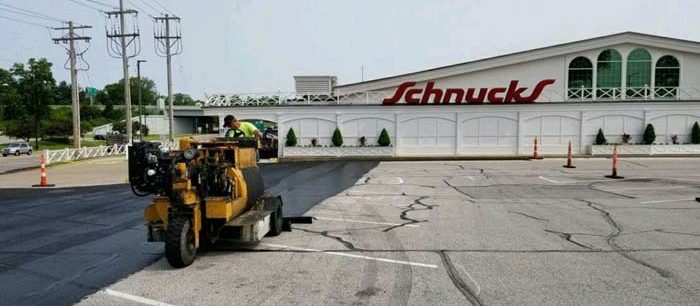Excitement About A1 Professional Asphalt & Sealing Llc
A1 Professional Asphalt & Sealing Llc Fundamentals Explained
Table of ContentsThe 7-Second Trick For A1 Professional Asphalt & Sealing LlcGetting The A1 Professional Asphalt & Sealing Llc To WorkGetting The A1 Professional Asphalt & Sealing Llc To WorkA1 Professional Asphalt & Sealing Llc Things To Know Before You Get ThisThe Greatest Guide To A1 Professional Asphalt & Sealing Llc

The oil in a car engine is not just oil. It consists of a selection of additives to improve the lorry's efficiency. These consist of polymers, thickness modifiers, warm stabilizers, added lubricants, and wear ingredients. The REOB contains all the ingredients that remained in the waste oil as well as the wear metals from the engine (mostly iron and copper).
However, by making numerous blends using different REOB examples and different asphalt binders, the variations largely can be balanced out. Numerous States gave samples of well-known REOB make-up to TFHRC researchers, that examined the samples to compare the portion of included (known) REOB to the discovered (tested) quantity. The analyses revealed a comparable percentage of added and located REOB.
The smart Trick of A1 Professional Asphalt & Sealing Llc That Nobody is Discussing
None of those States understood that the asphalt they were acquiring contained REOB. One State insisted its examples had no REOB - https://www.imdb.com/user/ur180438932/.
Of the 1,532 samples tested, 12 percent had REOB, and some consisted of substantially high levels of it at 1020 percent. The greatest level was 34 percent in an example from Texas, which TxDOT had used in a patching substance. This testing also disclosed the existence of phosphoric acid in 11 percent of the samples, and 2 percent had ground tire rubber.
Two years ago at TRB's annual meeting, the Federal scientists held an REOB workshop and presented the searchings for of their research laboratory evaluations to a standing room-only group. Some companies do not especially outlaw REOB, they do enforce physical examinations that preclude its useeffectively a ban. Others do not ban it by requirements, but have contracts with asphalt suppliers to prevent using REOB
The Buzz on A1 Professional Asphalt & Sealing Llc
A handful do enable REOB, some within particular restrictions. Ohio and Texas limit degrees to less than 5 percent of the asphalt. To develop a trustworthy examination method that all States can use, the TFHRC scientists established a round-robin test plan. The individuals are 11 State freeway firms (Illinois, Massachusetts, Minnesota, Mississippi, Montana, North Carolina, Oklahoma, South Carolina, Texas, Vermont, and Wyoming), 2 independent screening labs, the Ministry of Transportation in Ontario, Queen's University in Ontario, and an Ontario paving professional.
The participants are evaluating the examples individually using the guidelines provided by the TFHRC researchers. The output will be a suggested AASHTO examination method that any type of State can take on and use.
The sidewalk with REOB, which lies 0.6 mile (1 kilometer) from the sidewalk without REOB, has the same subgrade, web traffic thickness, and environment. The section of Highway655 with 5 to 10 percent REOB revealed significant splitting. In this instance, the visibility of REOB was the recognized root cause of cracking at a reduced temperature levels.
A section of test pavement in Minnesota (MN1-4) discovered to include REOB likewise broke prematurely. The sidewalk done well for the very first 3 to 4 years, but after that began to split.
The Buzz on A1 Professional Asphalt & Sealing Llc
The tests were not comprehensive, yet they revealed that at levels of 6 percent or more, the tensile toughness of the asphalt dropped considerably. At a degree of 3.5 percent REOB, the variation in the physical test methods was more than the impact of REOB. Actually, it was tough for scientists to examine whether REOB existed.

One binder criterion thought about is the distinction between the reduced temperature vital requirements temperature level for tightness (S) in the flexing light beam rheometer and the flexing beam rheometer creep slope (m-value) noted as Tcritical. TC = TC (S) TC (m-value). Assessment of this criterion is still recurring. 2 independent research study teams, one from AASHTO and the other from the Asphalt Institute, concluded that more research is needed on the usage of REOB in asphalt.
Formerly, all asphalt screening gauged engineering residential or commercial properties such as tightness. These tests do disappoint what materials had actually been contributed to the asphalt. One sample obtained during the TFHRC research study had a really odd evaluation. The example had the complying with examination outcomes: Superpave PG 64-28 with a high temperature quality of 67.3 Tcritical on the bending beam rheometer was 6.7 degrees Celsius.

A1 Professional Asphalt & Sealing Llc for Beginners
These outcomes show there are weak points in the standard engineering screening procedures that might be exploited. The producer might have an economic advantage and the item passes all the standardized tests, but the item might not be helpful to look at here now making certain long-lasting efficiency. To address this issue and the expansion of new asphalt ingredients and extenders, TFHRC is beginning a research program to make use of portable spectroscopic devices, x-ray fluorescence spectroscopy, and Fourier change infrared spectroscopy to enable analyses to be carried out in the area as opposed to having to take samples back to the lab.